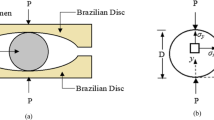Abstract
Concrete is a type of quasi-brittle material with high compressive strength and low tensile strength. To obtain the complete tensile stress-deformation curve of massive concrete specimens, a specially designed loading machine is proposed with a pair of hydraulic oil dampers parallel to the direction of the tensile loading. The dampers were designed with valves to modify the stiffness of the loading machine, enhancing the stiffness of the machine before the applied stress reaches 90% of the ultimate stress of the concrete. Several experiments were conducted with the proposed loading machine on prism-shaped specimens (size: 1350 mm× 450 mm × 450 mm), and the stress-deformation curves and mechanical parameters of the concrete were obtained. Finally, an empirical formula is presented and compared with the experimental results.













Similar content being viewed by others
References
Monteiro PJM, Miller SA, Horvath A (2017) Towards sustainable concrete. Nat Mater 16:698–699
Whitney CS (1932) Plain and reinforced concrete arches. J ACI Proc 28(3):479–519
Forquin P, Sallier L (2013) A testing technique to characterise the shear behaviour of concrete at high strain-rates. Dynamic behavior of materials. Springer, New York
Evans RH, Marathe MS (1968) Microcracking and stress-strain curves for concrete in tension. Mater Struct Res Testing 1(1):61–64
Hughes BP, Chapman GP (1966) The complete stress-strain curve for concrete in direct tension. Mater Struct Res Testing 3(30):95–97
Kulkalni SM (1993) New test method for obtaining softening response of unnotched concrete specimen under uniaxial tension. Exp Mech 33(3):181–188
Candappa DC, Sanjayan JG, Setunge S (2001) Complete triaxial stress-strain curves of high-strength concrete. J Mater Civ Eng 13(3):209–215
Carpinteri A, Ferro G (1994) Size effects on tensile fracture properties: a unified explanation based on disorder and fractality of concrete microstructure. Mater Struct 27(10):563–571
Zheng W, Kwan AKH, Lee PKK (2001) Direct tension test of concrete. ACI Mater J 98(1):63–71
Guinea GV, Planas J, Elices M (1992) Measurement of the fracture energy using three-point bend tests: part1-influence of experimental procedures. Mater Struct 25(4):212–218
van Vliet MRA, van Mier JGM (2000) Experimental investigation of size effect in concrete and sandstone under uniaxial tension. Eng Fract Mech 65:165–188
Philips PV, Zhang B (1993) Direct tension tests on notched and unnotched plain concrete specimens. Mag Concr Res 45(162):25–35
Chen X, Wu S, Zhou J, Chen Y, Qin A (2013) Effect of testing method and strain rate on stress-strain behavior of concrete. J Mater Civ Eng 25(11):1752–1761
Akita H, Koide H, Tomon M, Sohn D (2003) A practical method for uniaxial tension test of concrete. Mater Struct 36:365–371
Roseh H, Hilsdof HK (1963) Deformation characteristics of concrete under axial tension. Vorunter-suchungen, Munich, Berieht
Vassaux M, Richard B, Ragueneau F, Millard A (2015) Regularised crack behaviour effects on continuum modelling of quasi-brittle materials under cyclic loading. Eng Fract Mech 149:18–36
Shah SP (1965) Effects of flexural strain gradients on microcracking and stress-strain behavior of concrete. Journal of ACI 62:805–822
Graybeal BA, Baby F (2013) Development of direct tension test method for ultra-high performance fiber-reinforced concrete. ACI Mater J 110(2):177–186
Chen X, Bu J, Xu L (2016) Effect of strain rate on post-peak cyclic behavior of concrete in direct tension. Constr Build Mater 124(16):746–754
Guo Z, Zhang X (1988) Experimental investigation of complete stress-deformation curves of concrete in tension. J Building Struct 9(4):45–53
Chen Y, Du C, Zhou W, Li J, Li D, Sun F (2010) Experimental study on the complete stress-deformation curve of full grade concrete under axial tension. J Hydroelectric Eng 29(5):76–80 (in Chinese)
Rüsch H (1960) Researches toward a general flexural theory for structural concrete. Am Conc Inst J Proceedings 32(1):1–28
Popovics S (1970) A review of stress-strain relationships for concrete. J ACI 67:243–248
Acknowledgements
This paper was supported by the National Natural Science Foundation of China (Grant No. 51579084) and Jiangsu province key r & d project (Grant No. BE2017167).
Author information
Authors and Affiliations
Corresponding author
Rights and permissions
About this article
Cite this article
Du, C., Chen, X., Yang, Y. et al. Experimental Study on the Complete Tensile Stress-Deformation Curve of Fully Graded Concrete. Exp Tech 42, 491–497 (2018). https://doi.org/10.1007/s40799-018-0250-5
Received:
Accepted:
Published:
Issue Date:
DOI: https://doi.org/10.1007/s40799-018-0250-5



